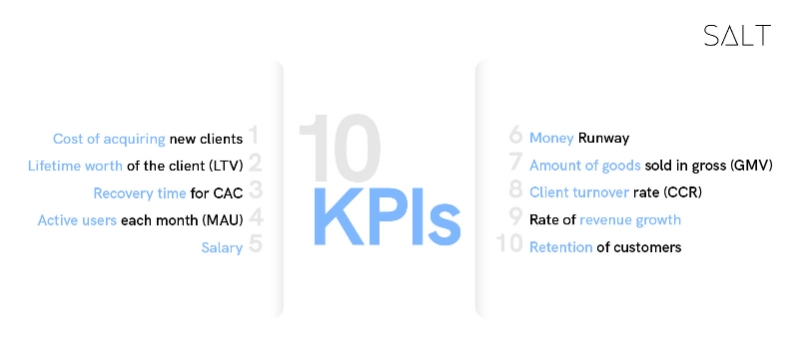
Key performance indicators or KPIs are quantifiable metrics that assist businesses in assessing how successfully they are reaching their objectives. By dividing things into manageable goals, key performance indicators can keep initiatives on track and keep enormous goals from seeming overwhelming. Choosing your key performance indicators carefully will help you stay focused and productive.
In this post, we take a closer look at what KPIs are, and then discuss 10 KPIs you need to have figured out before pitching your startup.
What is a Key Performance Indicator and why is it important for any startup?
Key performance indicators are a great way to track progress towards a certain objective. KPIs provide benchmarks to measure progress, goals for teams to work towards, and core insights that help people all around the organisation make better decisions. Using key performance indicators will enable startups to likewie monitor their progress and determine whether their current efforts are yielding the desired results.
If you don't monitor key performance indicators, all of your decisions will be influenced more by your personal preferences than by facts. You can build your startup and steer it in the correct direction by using key performance indicators to help you make smart, data-driven decisions.
Now that we know what KPIs are, the significance of each key performance indicator should also be understood, rather than just knowing the names of the indicators themselves.
What are the 10 Key Performance Indicators Any Startup Should Follow?

Here is a list of KPIs you should figure out as a startup before presenting a pitch:
Cost of acquiring new clients:
The cost of acquiring a new customer (CAC) is arguably the most significant key performance indicator for startups. You may figure it out by totaling up all of the money you spent over a specific time period on bringing in new clients, then dividing that total by the overall number of new clients you brought in. It is important to consider both your blended acquisitions across all of your marketing channels, and your users acquired through paid channels.
Active users each month (MAU):
The total number of users actively utilising your product each month is referred to as the MAU. It provides a brief summary of your user growth. Additionally, it helps you understand how well your firm can draw in new customers and keep hold of current ones. You can swiftly respond to both good and negative changes in your consumer base by tracking MAU.
Lifetime worth of the client (LTV):
The lifetime value (LTV) of a customer is the entire amount of money they will spend with you on your goods or services. You can't tell if you're overspending to attract customers or if you are ultimately losing money if you don't measure your LTV. You can choose to concentrate on historic LTV, which is based on actual purchases, or predictive LTV, which is based on what you anticipate customers will spend.
Recovery time for CAC:
This KPI counts the number of months it takes for a customer to generate enough net income to pay the CAC. Cash flow and runway are directly impacted by the time to recover CAC. While overhead measures the company's fixed expenses incurred regardless of the number of customers acquired, CAC measures the variable costs related to customer acquisition.
Salary
This is arguably the biggest expense any startup has, and therefore it’s also one of the most important KPIs you need to monitor. Potential investors would want to see whether you pay lower than average salaries (which might raise questions regarding employee-retention) or more than average salaries (which could decrease your startup’s runway super quickly).
Money Runway:
Any startup's survival depends on its ability to keep a sharp focus on the runway. Runway is a word used to represent how many months remain until the business runs out of funds. By dividing residual cash by monthly burn, the runway is calculated. Entrepreneurs that have limited runways tend to be myopic and unable to make essential adjustments. Additionally, it forces them to give almost immediate attention to the next round of fundraising rather than expanding the business.
Amount of goods sold in gross (GMV):
GMV can be a helpful key performance indicator. GMV, or gross merchandise value, is the total amount paid for products or services that were bought online. However, some companies discover that their revenue may not be the most accurate predictor of their financial performance. This is particularly true for markets where revenue only accounts for a small share of total transactions.
Client turnover rate (CCR):
CCR can be used to determine how quickly customers are leaving your startup. It is determined by dividing the overall number of consumers who stop doing business with you during a given period of time by the overall number of clients you had during that same time. It is essential to comprehend the state of your startup. Additionally, it may be used to spot changes that either make it easier or harder for your firm to keep clients.
Rate of revenue growth:
How well your startup grows its revenue over a specific time period is indicated by its revenue growth rate, e.g., a month, quarter, or year. Subtract the revenue generated in the current period from the revenue of the prior period to arrive at the calculation. Then, multiply the outcome by 100 after dividing it by the current period's revenue.
Retention of customers:
Getting new clients is critical, but keeping them is even more crucial. The percentage of paying customers who continue to be paying customers over time is known as your customer retention rate. Churn, or the proportion of clients you lose in a specific time period, is the opposite of retention rate. When a corporation has a sticky product and is keeping its customers satisfied, we see strong retention rates over a deterministic time period. This also serves as a measure of capital effectiveness.
Conclusion:
Key Performance Indicators connect your culture and purpose by uniting employees towards a single objective, as KPIs are a useful approach to gauge and monitor a startup’s performance on a number of distinct parameters. Managers may better optimise the company for long-term success by knowing exactly what key performance indicators are and how to use them properly.
Salt is a neobanking solution, on a mission to make business banking easier than ever for you by simplifying cross border payments. Give our website a visit today to learn more about us!


